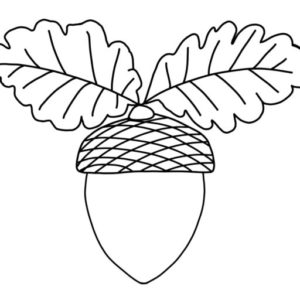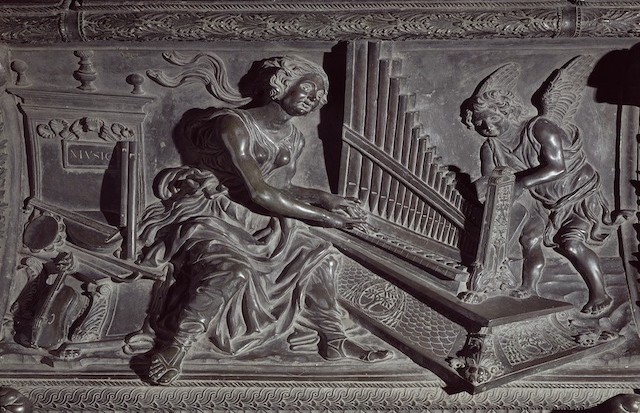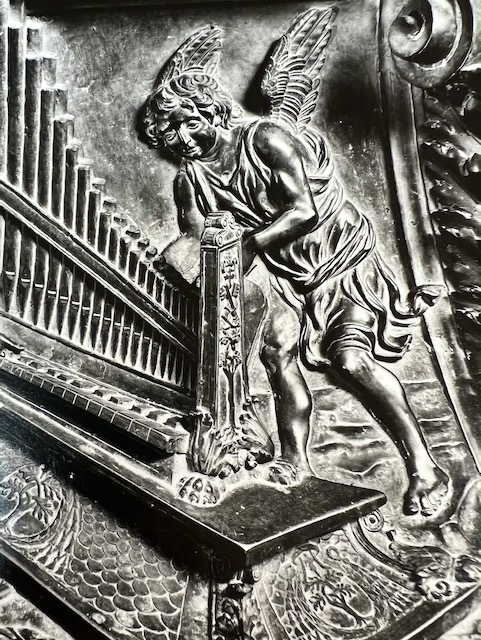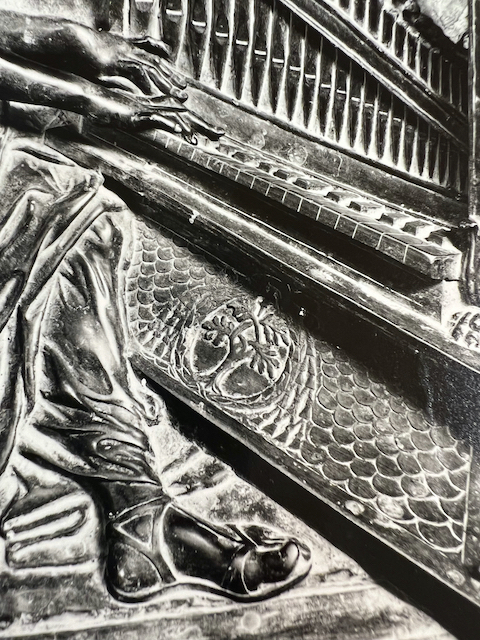Music
Musica (figure 30) occupies the central panel on the right side of the tomb. She plays the organ inscribed with two della Rovere oak tree symbols on the pedestal. The allusion to the pope’s patronage of music is further indicated by the inclusion of the papal keys and papal tiara on the side of the organ itself. As Sixtus IV enlarged the choir of the Sistine Chapel from 16 to 24 members, Musica can be understood to have a significant role in the pope’s mastery of the Liberal Arts and signifies his direct patronage over this discipline.[84] It is noteworthy that she is the only discipline with the papal keys depicted on the organ along with the della Rovere oak branch and tree (see figure 31 for detail). Thus, Music evidently is placed in high regard as this discipline is further connected to the papacy, as well as the chapel and its choir. As the only figure without an inscription, Musica is distinct from the other disciplines, especially considering that musicians would typically have a book of music placed in front of them. However, it communicates the point that the discipline of music is one that cannot be solely learned from books and instead entails mechanical study, requiring more than just the intellect. On the left are many instruments, including a tambourine, lute, viola, flute, and trumpet. The choice in depicting Music playing the organ is twofold. It reflects Sixtus’s general interest in music but refers more specifically to his patronage in acquiring a pair of organs and the construction of five new organs in St. Peters. By playing the organ, the figure of Music is best able to display her body.[85] Instead of being closed off behind a lute or lyre, the organ allows for a twisting movement within her body, and was moreover considered more respectable for women than stringed or wind instruments.
To the right of Music is a young angel or spiritello pumping the bellows of the organ (figure 32), which, by the direction of their flowing robes, seems to have flown in from the right side. However, this notion of wind blowing from left to right is complicated by Music’s dress and a ribbon that emanates from her head. The wind makes the ribbon and the top half of her dress billow out further to the left as if the wind is blowing right to left. The wind doesn’t adhere to the constraints of nature, instead, it forms the dress into a mold of her breasts, accentuating them as if she was bare-breasted, similar to other disciplines throughout the tomb. This notion of the wind blowing the cloth to show the nude body underneath suggests that Pollaiuolo adhered in some respects to Leon Battista Alberti’s treatise On Painting.[86] In it, he writes that graceful bodies should be shown in the “face of the winds Zephyrus or Austrus who blows from the clouds making the draperies move in the wind. Thus, you will see with what grace the bodies, where they are struck by the wind, show the nude under the draperies in suitable parts.”[87] The figure of Music embodies Albertian grace through a more restrained and gentle movement of wind against her body. Although this wind is most prevalent in the figure of Music, the notion of wind pressing up against the body and displaying the nude underneath the draperies can be found in many of the other allegories throughout the tomb. Thus, Pollaiuolo establishes a connection between the use of wind to create music and also uses wind to communicate a state of grace. Furthermore, to hear music, it requires sound to be transmitted through the air, establishing a connection between the wind as a creator of the sound reflected in the panel. Wind is also required to play many instruments, most notably the flutes and organ represented in the panel. By incorporating an additional sensory experience, Pollaiuolo adds a further dimension to the traditional allegory of music.
Music, or Harmony as she is called in Capella’s writing is introduced last, shown in the center, serving to connect both disciplines to her left and right on the tomb. She “ties all things together, unites parts of soul, binding it to the flesh and strengthening faith.”[88] In Capella’s writing, her head was ornamented with gold, her dress was stiff and had a gold shield with inner circles as well as gold model instruments in her hand. Alain de Lille’s description of Music also focused on the instruments that she played, with one hand holding a cithara, while the other struck a chord.[89] The cithara can be identified on the left half of the panel while the chord is visually shown in her playing the organ. Thus, the actions of Music directly correspond with Alain de Lille’s textual descriptions, which are visually represented within the panel. As there are no texts to cite other than the sheet music, Pollaiuolo both creates invention in her position and dress, yet adheres iconographically to earlier texts.
Figure 30. Antonio Pollaiuolo, Tomb of Sixtus IV, Detail of Musica, c.1484-1493
Figure 31 and 32. Antonio Pollaiuolo, Tomb of Sixtus IV, Detail of Musica Papal Keys and della Rovere Oak Branch, c.1484-1493



